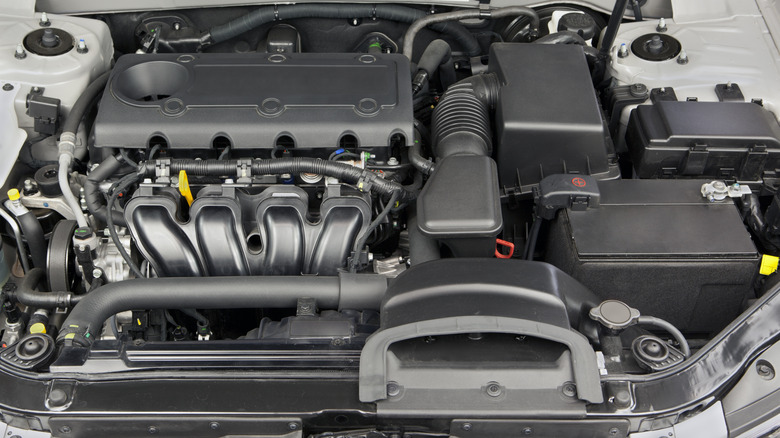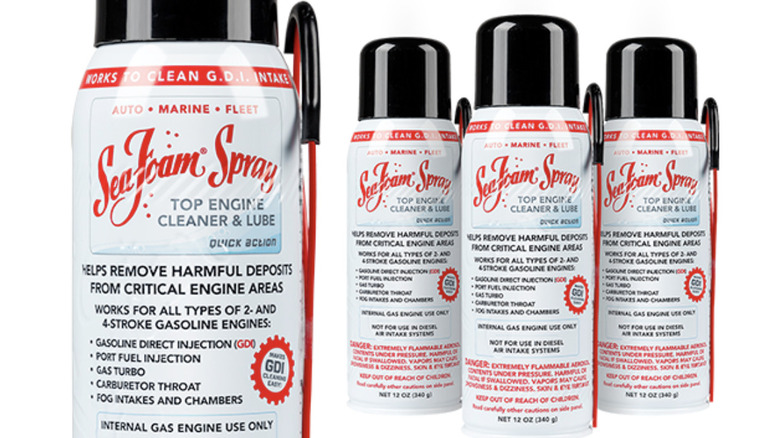What Is Sea Foam And Should You Use It In Your Vehicle?
We may receive a commission on purchases made from links.
Visiting your local auto parts store will put you face-to-face with a baffling array of products that promise to make your car or truck run more efficiently, smoother, or longer without breaking down. You've probably seen bottles of STP engine treatment, a variety of fuel injector cleaners, and something called Marvel Mystery Oil. Nestled among these purportedly helpful substances on parts store shelves you'll find Sea Foam Motor Treatment, but does dumping the contents of this white can into your engine do anything but lighten your wallet by a few dollars, or is Sea Foam helpful?
Sea Foam engine treatment is made primarily of a blend of three petroleum-based oils that clean and lubricate your engine's internal components, along with a small amount of isopropyl alcohol that helps treat fuel that has been contaminated with small amounts of moisture. It is completely safe to use in any engine, and can do some good, particularly in older, well-worn engines. This engine treatment product comes in two forms: A liquid that is added to fuel in the tank at a ratio of at least one ounce per gallon of fuel, and an aerosol spray that is emptied directly into your vehicle's air intake, downstream of the mass air flow sensor and as close to the engine as possible.
Sea Foam cleans carbon deposits from inside your engine
You can also add the liquid to your engine oil via the oil filler cap at a ratio of one ounce per quart of oil, but the most effective way to clean deposits is using the aerosol spray. On most vehicles, you can disconnect the air intake tube and spray Sea Foam directly into the throttle body. Warm the engine up first, and empty the entire can of spray while an assistant keeps the engine running at 1,000 rpm above idle speed (usually between 500 and 2,000 rpm). After the can is empty, let the contents sit for about 10 minutes and then drive the vehicle for at least 10 more minutes to let Sea Foam do its work.
You'll see white smoke coming from the tailpipe; this means Sea Foam is helping release and burn carbon deposits from your cylinder walls, piston rings, valves, and other engine components. The fuel additive will work to clean your fuel lines and absorb moisture in the fuel, while the solvents in the spray applied to the intake dissolve deposits inside the engine and assist in cleaning the fuel injectors.
The thickness of the smoke in the exhaust will tell you how much goop is being removed from inside your engine. This is the only time you'll want to see a dense cloud coming from your tailpipe — this tells you that you're getting your money's worth from those cans of Sea Foam.
Sea Foam is best in GDI and older engines
Sea Foam is most useful in older engines where deposits have built up or in GDI (Gasoline Direct Injection) engines, where the fuel is injected directly into the cylinders. GDI made our list of the auto industry's best fuel delivery innovations, but these engines don't circulate fuel through the intake valves, which can lead to buildup there. Sea Foam liquifies carbon deposits in the valves and other sludge inside the engine so they can be burned with your fuel. It will also help free sticky valves, although it's not going to help if you have a collapsed lifter.
I have been working on my own vehicles for more than 30 years, and often buy and restore older Jeeps and other vehicles. Using Sea Foam in a newly acquired high-mileage vehicle has become a habit of mine, and seems to be well worth the minimal expense (a 16-oz can of the liquid currently sells for $11.49 at Autozone, and Amazon currently sells two 12-oz cans of the spray for $21.20).
Sea Foam won't undo major engine damage caused by owner neglect or mechanical defects, but it certainly seems to make my older, tired engines run a bit quieter and smoother. For the price of a few similarly sized lattes or one overpriced restaurant appetizer, it most definitely can't hurt.

